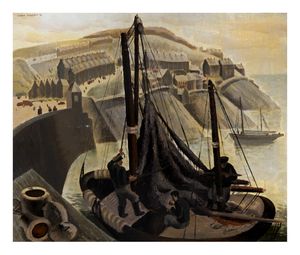Nutter Buzacott
- Date of birth
- 1905
- Date of death
- 1977
- Notes
- Nutter Buzacott was a painter, printmaker, illustrator and commercial artist. He was born in Perth in 1905. After his father died he moved to Melbourne with his mother to join his grandfather, a noted seascape painter, at Caulfield but spent his holidays with his grandmother at Kalgoorlie. In 1925 Buzacott left Melbourne to study commercial art in Sydney. After returning to Melbourne he drew fashion designs for various commercial art studios and became friends with a young developing group of commercial artists, including James Flett, Dominic Leon and Mervyn Wallis. Together they began experimenting with various printing methods, especially linocut, lithography and etching. In October 1930 Buzacott helped found “Strife”, a magazine that lasted only one issue before being banned by the police. He drew woodcuts in it as “N. Vellis”. In 1930 he exhibited with "The Embryos", and in 1931, along with Roy Dalgarno, James Flett, Eric Thake, R.V. Francis, J. Vickery and Bill Dolphin, exhibited as “The New Group”, at the Athenaeum Gallery. Buzacott was then sharing a studio with Noel Counihan and Roy Dalgarno and had become increasingly attracted to Marxist ideals. He used stark black and white wood and linocuts to convey the mood of the Depression and draw attention to its victims. In late 1931 Buzacott was a foundation member of the Workers Art Club. In 1933 he met and married Winifred McClintock. Three years later, he used two small inheritances to travel to England where in 1936-38 he studied with Iain MacNab at the Grosvenor School, London. Buzacott returned home in 1938 and soon moved to Warrandyte. He continued to exhibit with a group formed in Melbourne in 1935, the New Melbourne Art Club, which included James Flett, Roy Dalgarno and Edward Heffernan. In 1942 he exhibited at the Kadimah cultural centre in Carlton alongside Yosl Bergner, Noel Counihan, James Wigley and Vic O’Connor. During the Second World War he joined the Cartographic Corps of the army stationed in Bendigo and Brisbane. Buzzacott and other artists were trained in plotting aerial photographs which became the major source of wartime mapmaking. Buzzacott also designed posters for the war effort. He exhibited in Melbourne with other soldiers known as "The Five Group" during the 1940s. He sold his paintings only to friends and acquaintances while continuing to make a living from commercial art and from illustrating pamphlets and books, including Alan Marshall’s “These Are My People”. He was transferred back to Melbourne to Design Division in 1943 and became Art Director for United Service Publicity, founded 1945 by returned soldiers. He became a freelance commercial artist around 1946; by then, he was mainly painting landscapes. In 1949 Buzacott left Melbourne for Brisbane to work in commercial art and lived in Wynnum, near Brisbane, site of an artists’ colony that developed around John Manifold, a communist poet and musician. He continued to paint landscapes while employed on commercial art and teaching at Queensland Institute of Technology. He won the Redcliffe Art Prize in 1969. Later he moved to South Tweed, where he died in 1976.

